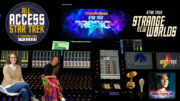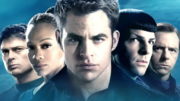The Enterprise will look more spectacular than ever when Paramount and Bad Robot release a special version of Star Trek Beyond for the fledgling Barco Escape cinema format.
Barco Escape is an ultra-widescreen process that projects a film across three stitched-together screens that wraps around the front of the theater, delivering a more panoramic and immersive experience. The process is reminiscent of the old Cinerama format, which had it’s heyday in the 1960’s.
Star Trek Beyond was shot for traditional theatrical exhibition, so Bad Robot is retrofitting the film to accommodate the wider format. From The Hollywood Reporter:
“When you’re on the bridge of the Enterprise, you might see additional coverage of the bridge,” Bad Robot producer and head of visual effects and post Ben Rosenblatt told The Hollywood Reporter. “Or you might see the Enterprise coming across the screen — and maybe you’ll see more and the attacking forces. There are new ships and antagonists that are well suited to the expanded image.”
For this version, Bad Robot will be remastering the film, with certain sections of the movie expanding to reach out across the panoramic tri-screen display — “at least 20 minutes, hopefully more,” said Rosenblatt.
Star Trek Beyond director Justin Lin and J.J. Abrams, who directed the first two films in the franchise reboot, will be leading the creative, which will be a cooperative effort between Bad Robot’s in-house VFX unit, Kelvin Optical; the film’s lead VFX house, Double Negative; and VFX house Atomic Fiction.
Since the film was already shot when the deal was completed, the expansion of the imagery into the side wall screens will be, in some parts, fully CG extensions of the VFX shots. Rosenblatt said some shots will incorporate production footage that wasn’t used in the wide release version, while others would be a combination of production footage modified with VFX.
Barco’s hope is to have the film playing on up to 50 screens this July, just in time for STB’s release. To find out if there’s a theater near you, click here.
Star Trek Beyond will hit the big (and bigger) screen on July 22.






“so Bad Robot is retrofitting the film to accommodate the wider format.” OK… we’ll see how that looks. I wonder if that was part of the re-shoots?
This is a horrible idea,
They tried this with Maze Runner, all it is is adding extra imagery on to the sides to fill a wider screen.
& the problem with that would be?
So did ILM not provide the cgi for this movie??
ILM has been mentioned as a secondary VFX vendor, but never as the primary. DNEG is a fantastic VFX house, I consider this an upgrade (was not impressed with the gauzy look of the ship in space stuff in the last two — only the closeups of the KELVIN really looked like physical objects to me — so I hope DNEG improves on things.)
I’m cautiously intrigued by this wider screen notion; I’ve seen how Ken Adam revisited his old DR STRANGELOVE concept art for the war room and expanded them for an exhibition and it worked pretty well. Also, changing aspect ratios worked very well in BRAINSTORM, though that was planned out from the start rather than being retrofitted into the thing late in the game.
Face it, seeing the ship shot to hell and blown to pieces is something that deserves ‘spectacle’ treatment, assuming you can keep everything sufficiently high-rez.
You’re right, I just looked at their website. They’ve done a lot of films that I thought ILM did and their work is stunning! Definitely not a Trek 5 situation in terms of VFX by losing out on ILM.
Well, technically, ILM *did* have a small scene in STV. Admittedly, it was taken from STIV, but still…:)
I daresay, though, the days of ILM being a primary FX house on anything outside of “Star Wars” and the odd Cinematic Universe film are all but over.
No, ILM still gets a huge amount of work on all sorts of shows. They’ve still got a hunk of talent and have gone into a lot of countries too.
I suspect Disney is keeping ILM very busy these days. That could be good, allowing other companies to get a look at FX work that they might not have otherwise.
This film has a smaller budget than the last film and I suspect DNEG’s services cost significantly less than ILM’s as an effects house based overseas.
I’m pretty sure I’ve read that ILM also has facilities overseas. Most big VFX houses have. It allows them to work around the clock without having to pay people for nighttime.
“The Enterprise will look more spectacular than ever” thanks to blowing it up. Hope 1701-A is different for the better.
I have a feeling they will include a shot of a new Enterprise that is more in keeping with the original or at least TMP design. Which will be great…but all too late.
Resorting to gimmick. Does not bode well…
Studios and production companies try new things all the time. Not a big deal.
A gimmick for sure, along with junk like Sensurround and William Castle’s “Emergo”, “Percepto”, “Illusion-O”, etc. ;)
The story comes first. If it’s good, the gimmicks will not matter either way.
I would love to see a movie that was shot for this format, but I don’t support cash-grab after-the-fact 3D conversion and I won’t make an effort for this.
Sniff…..does anyone else smell turkey?
I do. And it’s on it’s way out of the kitchen …,
My turkey sandwich smells nice…
Get your nose checked….
As a complete surprise to myself, my friends and the rest of the audience who went to see The Scorch Trials, our theater was equipped to show it in this format, and we forced to watch our movie this way.
Bottom line… I hated it.
There are several reasons why this format is actually a step backwards to an enjoyable film experience:
1.) Cinerama already did this decades ago, before I was born, and they did it better. This “new” format is nothing new at all. I saw 2001: A Space Odyssey in 70MM at the Cinerama Dome in Hollywood years ago, and the experience was revelatory. This doesn’t come close.
2.) The two side screens are not as tall as the main screen, so the picture on the main screen must be reduced to match. As a result, the screen real estate that really matters is chopped down, only to add unnecessary additional filler on the sides.
3.) I say “unnecessary” visual filler, because only roughly 20% of the film took advantage of the wider format, by extending establishing shots and some action sequences. However, the “joins” between the screens did not match well and were off-putting. The remainder of the time, weird elongated colored “shadows” were projected, which reflected off of the main screen and reduced the clarity of the main image.
4.) The digital cameras that project the side screens are inside the theater itself, so the fans that keep them cool are extremely loud. As a result, quiet moments in the film are ruined because of the endless whirring fan noise, and this is especially noticeable when people on screen speak softly and you can’t understand them.
5.) It appeared that most of the projected side material was not shot at the time of actual filming, but created in post using CGI. This is very noticeable when you are looking at a cityscape. (Yes, some of that imagery is CGI, too, but the resolution of the side imagery was not as clear.)
6.) Finally, what made the film experience even worse was that we were forced to sit through an almost 10-minute trailer for Barco that showed off the technology through first-person video shot for extreme sports. Ironically, as overlong as the trailer was, it did a better job of showing off the potential of the format than the movie did. That didn’t help.
Any upcharge for this format is a total waste of money. Spend it on a bigger screen or a D-Box seat if you really want an “experience.”
–M
Fun! Was always jealous of those that got to experience true Cinerama back in the 50’s…very cool to be able to finally see something similar. Being Trek is just gravy!
I saw “Maze Runner 2” in this format. There were some cool shots where there was actual filmed material that panned across all three screens. There were a lot of VFX extensions, such as extended cityscapes and desert. I can see that working with the planet they’re on or the space shots.
However, while most were okay, some were poorly done VFX and looked noticeably more CG. Hopefully, considering Trek has a significantly bigger budget, more time and money will be spent on this.
I won’t mind seeing this. It’s just a fun gimmick. It work really make the movie itself better or worse.
How does that translate on a regular TV? Is it a thin veil of image with gigantic black bars on the top and bottom???
I’m asking since this is one day going to come out on DVD/Bluray, right?
It’s just an in-theatre experience. I doubt it would be released on home video that way.
MattR,
Oh ye of little faith. If they could find a way to stitch together all three of HOW THE WEST WAS WON’s Cinerama screens for blu-ray:
http://www.dvdtalk.com/dvdsavant/s2625west.html
Then I’m confident its Smilebox solution be adapted to Barco Escape.
This article from THE VERGE:
http://www.theverge.com/2016/4/13/11424138/star-trek-beyond-barco-escape-jj-abrams-ben-rosenblatt
with Bad Robot’s Ben Rosenblatt, eveals JJ’s more involved with Baeco Escape in BEYOND than one would have thought.
eveals=reveals
Baeco=Barco
In digging around to see what kind of footage BEYOND’s cinematographer, Stephen Windon, filmed that Barco could be using as a source, I found that he used “The ARRI Anamorphic Ultra Wide Zoom AUWZ 19-36/T4.2 … the widest professional anamorphic lens in the world”:
https://www.arri.com/news/news/wide-angle-anamorphic-perspectives
”On the set of the next instalment(sic) in J.J. Abrams’ highly successful STAR TREK film series, cinematographer Stephen F. Windon ACS, ASC has also been combining the new zoom with Master Anamorphics and pushing the boundaries of what has previously been possible with the format. “I’ve been using ARRI’s Anamorphic Ultra Wide Zoom on the feature film STAR TREK BEYOND and I find that it complements my ARRI/ZEISS Master Anamorphic lens package very well indeed,” explains Windon. “Optically and technically the AUWZ is an incredible lens: a super-wide anamorphic zoom with a fast maximum aperture, extreme edge-to-edge sharpness and surprisingly minimal distortion. Barely a day goes by where we don’t use it.”” — ‘Wide-angle anamorphic perspectives’, ARRI Group, ARRI News
and this:
http://www.afcinema.com/Angenieux-30-72mm-AS2-Anamorphic-zoom-on-Star-Trek-Beyond.html?lang=en
”First production units of Angenieux 30-72mm AS2 Anamorphic lens are making a splash on the set of Star Trek Beyond (2016) with Cinematographer Stephen Windon ACS, ASC.
The Angenieux anamorphic zoom line has now expanded with this second lens in the series of three planned. The first two 30-72 2S anamorphic zooms have been delivered to Otto Nemenz Int’l in July and are already hard at work on the set of Director Justin Lin’s production of Star Trek Beyond due out in 2016, cinematography by Stephen Windon ACS, ASC.
“Stephen already had two 56-152 A2S zooms working on the production, so when we found out about the impending delivery of the 30-72 A2S lenses, he just had to have them”, said Fritz Heinzle of Otto Nemenz. Shortly after taking delivery of the first two units, they were off on location in Vancouver where the movie is being shot. “They initially used one demo 30-72 A2S, but shortly after came back with a request for another lens to put on a second unit production, timing couldn’t work out better”, said Fritz.
Cinematographer Stephen Windon, who is shooting Star Trek Beyond, said, “I’m owner of the fabulous 15-40mm Optimo, one of my favorite lenses in my kit. I knew the benefits of having a lightweight anamorphic zoom lens for remote head work and I love the energy of a hand held camera. With an anamorphic zoom such as the 30-72mm we can now achieve energetic shots with these remarkably light lenses”.
The release of the 30-72 A2S represents Angenieux’s ongoing industry leadership in designing new optical technologies that enhance technique and creativity for cinemascope production. With the success of the first anamorphic lens 56-152, the Angenieux anamorphic zoom line is further expanding production needs for cinematographers and DPs who want to give a dimensional character to their images for a multitude of productions.” — French Association of Directors of Photography; September 5, 2015
This sounds seriously lame & flawed.
If it was built around a rounded screen like cinerama with film filmed for that format it maybe it could work but this is just a gimmiky cash grab that will just add to the budget with little additional profit as even 1960’s audienced didn’t fall for it.
These are filmmakers experimenting with various mediums in order to see how a film may look from an audience’s perspective. It was explained that it can’t be screened in all cinemas, but it is hoped that 50 cinemas around the US will be show STB using this format. I think that to see some of a movie in this way would be extraordinary. It is simply another way of showing something. It also imitates more accurately how the human eye actually sees.